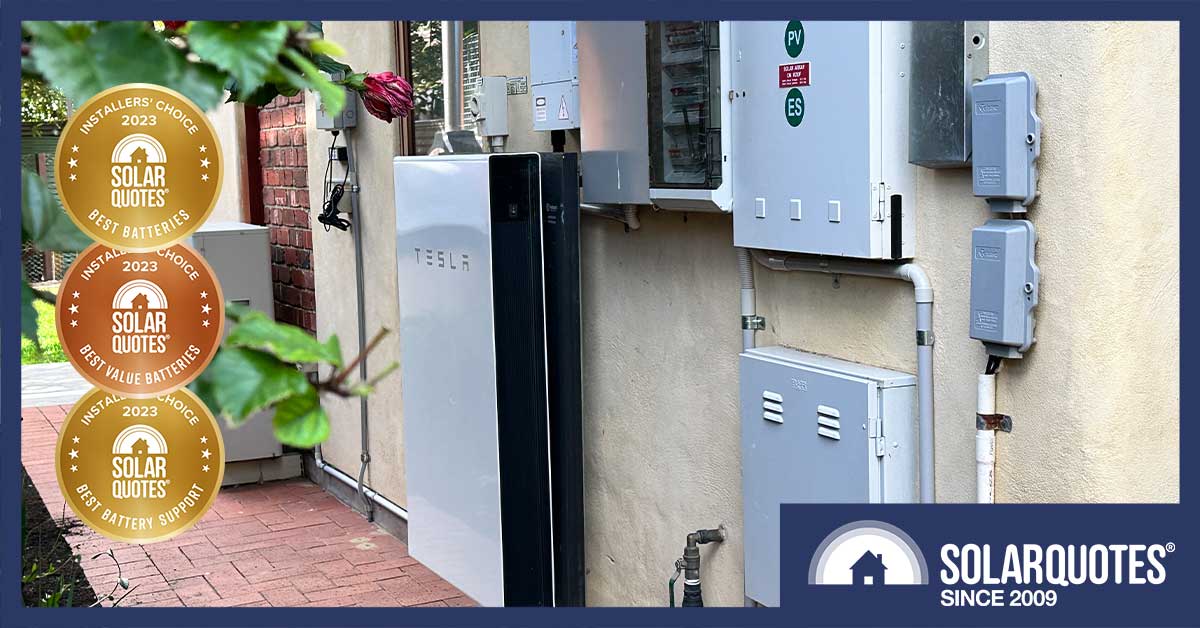
SolarQuotes has sometimes faced accusations of lacking independence, with critics suggesting Tesla must be footing the bill for our positive coverage of the Powerwall. We’ve also been accused of rigging Tesla’s gold medal in our 2023 Installers’ Choice Awards.
Tesla owns SolarQuotes
— Laurie Kelly (@LaurieAnneMD) March 6, 2023
So, is Tesla’s home battery really that exceptional? Or is Elon funnelling Dogecoin to Finn in virtual brown envelopes?
Confession time:
I’ve never installed a Tesla Powerwall…
I have no firsthand experience with a Tesla Powerwall. I’ve never unboxed one, mounted it on a wall, or gone through the commissioning process.
So, how can I comment on the Powerwall’s pros and cons?
Well, I’ve been to training courses, trade shows, and social events, and I know fellow installers who install Powerwalls. The consensus is clear: Tesla users and installers rarely have complaints. The Powerwall delivers on its promises; if it doesn’t, Tesla’s phone support sets it right.
The Powerwall’s Pleasures
Good Specs
Bad news travels fast, but the Powerwall has few critics. Its specs are solid; one model that you can expand by adding more units. And let’s be honest, when you have to stop at ten units1, a more industrial solution is probably required.
Until that point though, the Powerwall has a good surge capacity and offers good storage size considering its small footprint. A solar inverter’s monitoring can be cluttered with details that only energy nerds find scintillating, presenting numbers that don’t affect your yield much but causing needless worry and support calls for reassurance that just aren’t needed.
Great Gateway
Tesla’s gateway backup box? A sleek, easy-to-install solution that adds a significant amount of electrical infrastructure. It’s got room to satisfy the needs of at least three significant-sized cables and circuit breakers for incomings and outgoings.
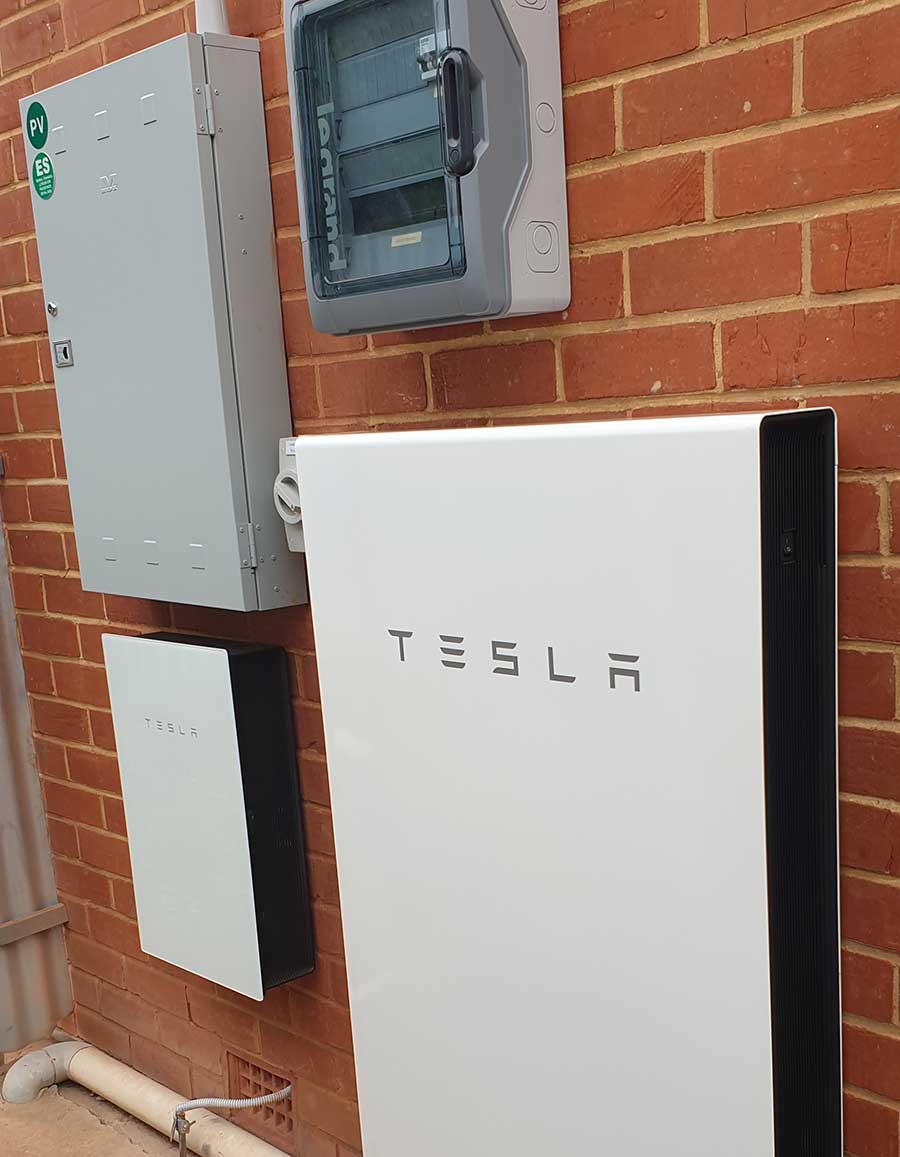
The Gateway handles backup and metering. It’s the little Tesla box at the bottom left. Install: DQ Electrical
Tesla’s Monitoring App
The Tesla app is clean, full of appropriate information and intuitive; so in many cases the punters use it as their default home monitoring platform.
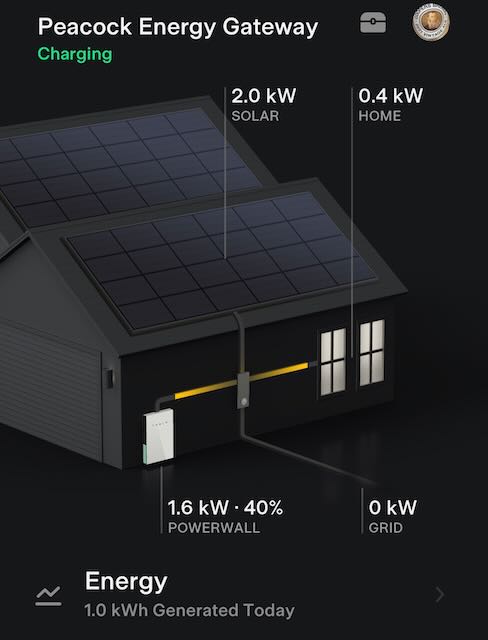
The Tesla App’s main screen shows the instantaneous generation, consumption, battery charging and exports (taken at 7am).
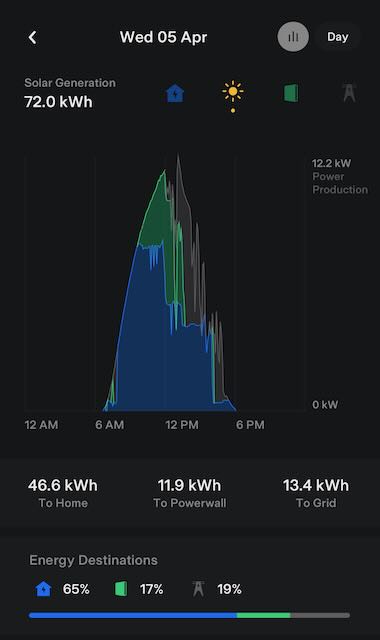
Where the solar energy went: blue=house consumption, green=battery, grey=grid. Self-consuming like a boss (with a non-Tesla EV and ChargeHQ integrated with the Powerwall’s API).
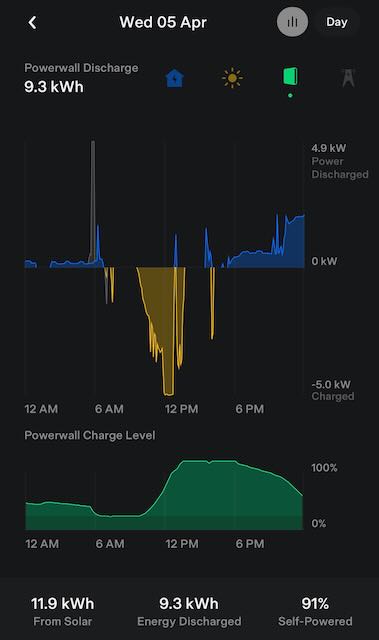
Battery energy screen: Above line = discharging the battery. Below line = charging the battery. Note the grey spike where the Tesla VPP pushes energy from the battery to the grid – most likely for frequency support.
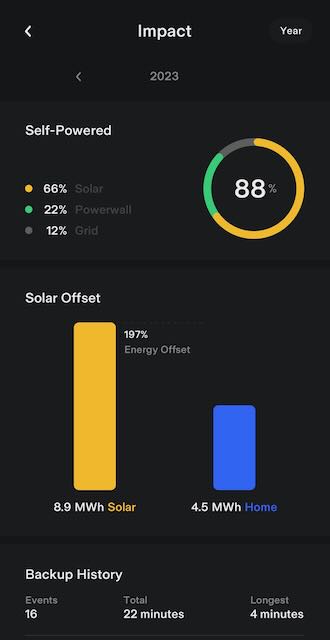
Solar and battery impact so far in 2023. This house is fully electric, has 2 EVs and a heated pool. 20 kW of solar + 1 Powerwall. Note that solar has 3x the impact of the battery.
The Powerwall’s Sorrows
Tesla’s monitoring is so good it creates a new problem: many Powerwall owners ignore the monitoring that came with their solar inverter.
You Still NEED Your Solar Inverter’s Monitoring Alerts
In the same way RCD/earth leakage safety switches are now mandatory in your switchboard to help prevent electric shocks from appliances and light fittings, your solar power system has earth fault monitoring built into the inverter. If the electrical insulation of the array on your roof breaks down and DC electricity leaks to earth, the inverter will shut down.
The kicker is that the Australian Solar Installation Standard, AS/NZS5033 : 2021 mandates there shall be an actionable alarm that you will notice in the event of an earth fault.
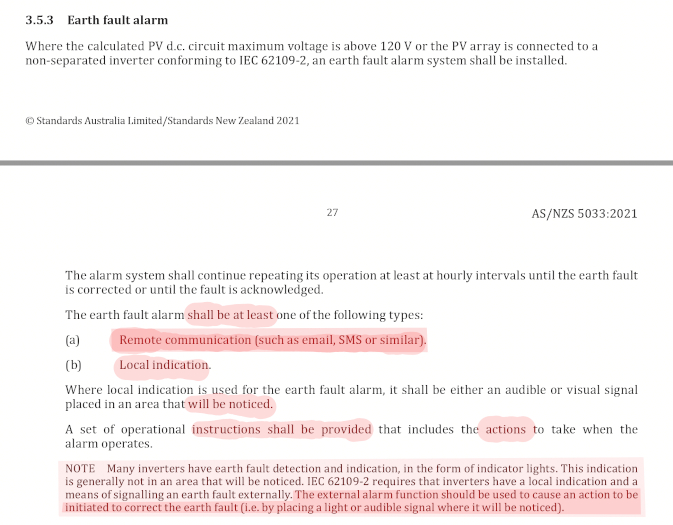
Some electricians argue (bless them) that a winking red or green warning light on an inverter is good enough if it’s in the garage because that’s a high-traffic area where you’ll see it. I reckon the last four words make that assumption pretty silly.
I can make a case for a buzzer, which would be enough to prompt people to call the repair team. However, an email from the inverter monitoring platform is an acceptable solution, especially for remote building management. An SMS is even better.
If you have a solar power system, watching the red and green lights is important. Also, you should know what they signify.
If you’re new to the house, you may need a technician to attend and reconnect the monitoring of an existing system to the internet, which helps with warranty cover and legal requirements for earth fault monitoring. In some cases, it’s essential to prevent damage. For example, an Enphase envoy may brick itself if you leave it running for too long without an internet connection.
Three-phase limitations
The Powerwall cannot be used to give blackout-proof backup to 3-phase loads. You can back up single-phase loads. You can spread your single-phase loads across 3 Powerwalls, one on each phase, but the units will not operate in a 120° rotation. It’s a feature that the 110 volt peasants in Tesla’s home market don’t have any demand for. Whereas Fronius prioritise 3-phase equipment over single-phase because Austria has no single-phase connections.
No more support for off-grid
Powerwall is no longer recommended for off-grid use2, so that’s a use case they don’t offer a warranty for. In fact, as a grid hybrid device, the Powerwall has also managed to disappoint a few customers who have found that while they can operate with AC-coupled solar to recharge during a grid outage, once the battery is depleted, they will not black start. The battery went flat overnight, and it would not recover and reboot in the morning.
Powerwall can limit your allowed solar capacity
One of the real features of the Powerwall (like any AC-coupled battery) is you can add it to premises with any legacy solar. It’s quite flexible in terms of being connected to a main switchboard or sub-board with wireless metering able to measure solar on different parts of the installation or phases. You can bolt it on anywhere, and it does its thing.
This flexibility proves problematic if your Distributed Network Service Provider (DNSP) deems the Powerwall’s integrated 5kW battery inverter as part of your 10kW connected inverter capacity; halting your ability to install the solar you need to charge the battery in the first place. In some instances, you can have 10kW of solar inverter and 10kW of battery inverter, but some more recalcitrant operators stipulate 10kW total.
For comparison, there are nominal 5kW hybrid solar inverters that offer a solar capacity of 10kW. Because the battery is DC coupled, the inverter can supply 5kW of AC loads in your house and charge the battery with DC straight from the array. You can claim STC incentives (AKA ‘the solar rebate’) for 10kW of solar3 instead of just the 6.6kW stipulated under the uniquely (silly) Australian rules. With AC-coupled systems, the rules prohibit oversizing the solar this way.
Powerwall Popularity Means Compatibility
Being one of the cool kids means you have more than a few options for connecting to external devices and services via Tesla’s Powerwall software interface4. Various virtual power plants allow you to buy and sell electricity with your battery and most of these can interface with the Powerwall. There are also smarts such as ChargeHQ that integrate your Powerwall and electric car charger to give you better control of where your solar energy goes.
It means that as anyone develops a new widget or killer app for battery, solar or energy management, they’ll ensure if possible it will be compatible with the ever-popular Tesla Powerwall. There are so many of them now that working with the biggest player is a commercial imperative.
In SolarQuotes’ 2023 Installers’ Choice Awards for solar batteries, Powerwall triumphed as the best home battery overall category for the third year in a row. It also grabbed 3rd spot in the “best value” (budget) category and was voted no.1 by installers for best after-sales support.
Footnotes
- Although there are reports that ten Powerwalls on one gateway have serious issues. ↩
- Word on the street is that Tesla was fielding too many support calls from off-gridders, so they pulled the plug on off-grid-support. ↩
- Or even more, depending on the inverter’s allowable DC input ↩
- Be aware that interfacing with the Powerwall API is often unofficial/unsupported by Tesla, so could – in theory – be pulled by Tesla at any time. Like the Twitter API was… ↩

 RSS - Posts
RSS - Posts



In Tasmania our winter sun hours are too few to recharge a powerwall, by my calculations a battery will only save me $500pa with my 5kwhr system. Getting the long summer sun hours of Tasmania at least the feed in tariff credit pays for most of my winter bills. Fingers crossed feedin remains worthwhile.
If I charge my 10kWh battery from the grid at $0.08 after midnight and use that 10kWh during the evening peak I save 10x($0.32-0.08) = $2.40 per night. x 365 = $876 per year, with all my PV going into the car and pool pump, not the battery. Problem is this will take over 15 years to offset the cost of the battery.
Hi Sean,
Sounds like a reasonable assumption. May people argue a battery isn’t just pure beancounting though. They like the notion of security and the idea of sticking it to the man. Some have a special use cases, like keeping an aquarium full of expensive fish alive.
In simple terms I like to point out a deep freezer might cost $1000 to refill if it thawed out while you were on holiday, not including the time spent cleaning it out or shopping for more food.
And it seems solar is something people expect will pay for itself, unlike a couch or a car which is expected to depreciate by half almost as soon as it’s delivered.
Have you tried our calculator?
Two of our sons have had Tesla Powerwalls for a couple of years.
BOTH are absolutely 100% happy, though run into the stupid problem with Energex that the solar inverter and Powerwall inverter both count towards their “allowed 10kW” inverter size.
This is absolutely insane!
What knuckle dragger thinks these rules up?
As an ex-electrical engineer (though out of the industry since last century), I just can’t believe many of their stupid rules!
I have a Tesla Powerwall 2 installed at our place in Townsville. It is connected to an AC coupled Enphase 6.5kW array. I have had all my inverters changed over at Enphase’s cost (but I had to pay the installer labour) since the systems were installed in March 2018. The inverters weren’t reporting due to “noise” in the system. Filters were installed but made no difference to my enphase inverters not reporting. The main reason I installed the enphase was that AC coupled is more safe than DC coupled wiring. I’m an electrician and have seen few DC systems go up in smoke. The second reason for installing enphase was the monitoring capabilty. It took about 10 months arguing with Enphase before the changed out the inverters. Since 2020 (touch wood) no dramas.
Back the Tesla battery. It performed exceptionally well up until Nov 2022 when it stopped reporting and would neither charge or discharge. So I had nearly 5 years of solid performance. I would use the Tesla App to see what my system was actually doing rather than the enphase while I was going through the inverter issue.
I one through the app diagnostic to restart as I thought the battery might have gone flat. After that didn’t work it was onto the Tesla phone support merry go round!
Since Nov 22 I have been on the phone countless times to Tesla ( the time difference is a shocker). They advised me my issue needed to be escalated and that would take 32 calendar days! I can see why they can’t support off grid systems. After 32 days I had to chase them when they advised me my installer would need to fix it! I advised them my installer no longer installed Tesla equipment because after they had sent 2 sparkies on the their 10 day course Tesla informed them that they weren’t a big enough company so would not get the opportunity to pay further $30k to become registered. Long story short I might be getting it repaired this week after being off line for 6 months. This is the worst customer experience I have ever had!
That is a saga. Let is know how it turns out.
How many inverters have you got?
I wonder what our Aus Trade Practices anti Restriction laws would do if the Elect industry challenged that in court. Very unfair to block out smaller companies like that and anticompetitive?
Very important the matter about electrical degrees. Congratulations! I would like you to answer a question mathematically based on what you described, 3 Powerwalls, one in each phase, but the units will not work in a rotation of 120°. So three single-phase inverters are out of phase by how many electrical degrees compared to 120º electrical three-phase?
Buying a Tesla Powerwall is like buying an iPhone. You get what they want you to get. There is no customization.
I have had a powerwall 2 in the USA (California) for about 3 years. I regret the decision frequently and would gladly trade them in for another system. There are very limited customization options and I have found that it is buggy as heck. It will work great for a while but all of a sudden, it will start powering my house in off-peak. This has been happening for 2 years and Tesla has basically told me to piss-off.
All they would tell me is “Engineering says that is what the algorithm says to do so it is working fine”. What they don’t add is “dumb customer, we know what you need better than you”.
Seriously? This battery is only there for emergency backup and to power my house during peak power rate periods (charging by solar during morning off-peak). It makes zero sense to start pulling power 1/2 hour before my peak rates start, just to run out before they end. I had 3 techs tell me that that isn’t a problem and each of them are either stupid, weren’t listening/understanding or lying.
So now I have to live with that, but for the last 2 months it hasn’t been operating correctly for about 3/4 of the days, either it won’t discharge or it won’t charge at all. This means that I’m paying peak rate electric charges (about 3x off-peak) when I shouldn’t be most days of the week. I didn’t realize it has been going on for a while until I got my last electric bill. I’ve been round-and-round with them some more. At least I have my installer agreeing that it isn’t working right, even though they first tried to say that it was (took 2 weeks to get past that).
At this point, I’d say I’ve lost out on at least $500 (US) in the last 3 years, Including $350 the past 2 months, just in the thing not working they way it was sold to me and nobody willing to fix it.
The 5kW inverter limit by some energy providers is a concern. How do I know for sure my 10kW of panels, inverter and Tesla battery is going to be allowed to do their thing, ie. fill the battery during the day, and let me use electricity off the battery from (especially) 500pm to 1100pm?
I just placed my order, Tesla or Sungrow batteries. Should I tell my (SolarQuotes best rated) installer that I’ll save the extra $$$ and stay with Sungrow (Tesla was a spouse decision, the Sungrow is not so pretty)? Why didn’t my installer warn me of this?